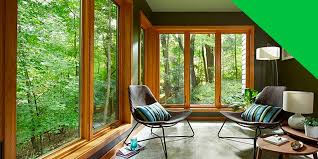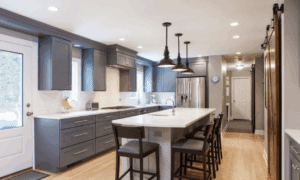Most homeowners think about windows in terms of insulation and temperature control—and they’re not wrong. A well-sealed window certainly keeps out drafts and reduces energy loss. But today’s windows do more than just manage heat and cold. They influence the entire indoor climate—light, airflow, humidity, and even mood.
Understanding how modern window replacement options contribute to a more balanced and healthier indoor environment can help you make better decisions when upgrading your home. The right windows can improve not just energy efficiency, but the way your home feels throughout every season.
What Is Indoor Climate, Really?
Indoor climate refers to the combination of temperature, humidity, airflow, natural light, and even noise levels within a living space. While heating and cooling systems play a big role, windows are the key interface between your home and the outside world.
When windows are outdated, poorly sealed, or limited in function, they contribute to uneven temperatures, trapped humidity, glare, or excessive noise. Newer window technologies aim to create a more responsive barrier—one that doesn’t just block out the elements but helps modulate your living environment in subtle and significant ways.
Companies like Ohio Windows & More understand that modern homeowners are looking beyond basic insulation. They’re seeking control, comfort, and balance—and that begins with choosing the right windows.
Humidity Control: A Lesser-Known Benefit
Most people associate windows with airflow, but few think of their role in moisture management. Poorly sealed windows or rotting frames can allow condensation to build up, especially during seasonal shifts. This excess humidity doesn’t just make rooms feel stuffy—it can lead to mold, mildew, and damage to woodwork or walls.
Modern windows address this with:
- Advanced weather stripping that prevents air and moisture leaks
- Composite frames that resist rot and water damage
- Multi-pane glazing with gas fills to reduce condensation risk
By keeping humidity in check, the right windows can support better indoor air quality, protect interior finishes, and create a more breathable home—especially in kitchens, bathrooms, and bedrooms where moisture levels fluctuate.
Airflow and Passive Ventilation
A consistent indoor temperature isn’t always about heating or cooling. Sometimes, what your home really needs is better airflow. Well-placed, properly functioning windows play a vital role in promoting cross-ventilation, which helps:
- Regulate humidity
- Reduce indoor pollutants
- Improve overall air freshness
- Lower reliance on mechanical ventilation
Choosing a mix of operable window styles—like casement, awning, or double-hung—allows homeowners to create airflow paths throughout the day. In many climates, this natural ventilation can help reduce AC usage during spring and fall, while still maintaining indoor comfort.
A knowledgeable window company can assist in planning window layouts that optimize air movement without compromising security or energy efficiency.
Daylight Balance: More Than Just Brightness
Light affects more than visibility—it shapes mood, sleep cycles, and productivity. Older windows may have dark tints, small openings, or UV issues that limit useful daylight. New window technologies are designed to maximize natural light while controlling its quality and impact.
For example:
- Low-emissivity (Low-E) coatings reduce UV penetration while allowing bright, clear light
- Larger glass surfaces with narrower frames open up the visual field
- Directional window placement allows you to manage light based on sun exposure
A good window replacement strategy doesn’t just brighten the home—it curates the right type and amount of light throughout the day. This is especially important for spaces like home offices, living rooms, and bedrooms where glare or harsh shadows can affect comfort.
Thermal Comfort, Not Just Insulation
While energy savings are important, thermal comfort is about how your body feels in a space. Drafty rooms, cold spots near windows, or overheating near direct sunlight can all make certain areas uncomfortable—even if your thermostat says the temperature is fine.
Modern windows help minimize these fluctuations with features like:
- Multi-pane designs that buffer against external temperatures
- Thermally broken frames that reduce conduction
- Tinted or reflective coatings that limit solar heat gain
These upgrades reduce the need to constantly adjust heating or cooling, making the indoor environment more stable and pleasant. It’s not just about efficiency—it’s about achieving a consistent feel throughout the home.
Acoustic Control and Peace of Mind
Noise is part of indoor climate, too. Whether it’s traffic, neighbors, or outdoor activity, unwanted sound affects relaxation and concentration. Many homeowners are surprised to learn how much window quality influences sound levels inside the house.
Modern window replacement solutions often include:
- Laminated or acoustic glass for sound dampening
- Thicker air spaces between panes for better insulation
- Tighter seals to prevent high-frequency sounds from entering
By upgrading your windows, you’re not just creating a quieter home—you’re improving the entire sensory experience of your space. This can be especially valuable for bedrooms, nurseries, or home offices.
Seasonal Adaptability
Climate isn’t static—it changes. From winter storms to summer heatwaves, windows need to perform consistently across extremes. Modern designs account for these shifts and provide homeowners with features that adapt throughout the year.
For instance:
- Double-hung or tilt-in designs offer easy cleaning in spring
- Screens and UV coatings support airflow and sun control in summer
- High-performance glass maintains insulation in cold months
- Condensation resistance protects during sudden temperature drops
Choosing windows that meet the needs of your local climate—not just one season—adds to the overall resilience and comfort of your home. A seasoned window contractor can help assess which features will serve you best year-round.
Long-Term Comfort and Control
Ultimately, the value of modern windows lies in their ability to create a well-balanced living space. By managing more than just hot and cold, they contribute to a healthier, more enjoyable lifestyle. This level of control helps homeowners feel more connected to their environment—less reactive, more proactive.
Working with an experienced provider like Ohio Windows & More ensures that your choices reflect your goals, whether it’s comfort, air quality, or seasonal adaptability.
Conclusion
A true indoor climate strategy doesn’t start with your thermostat—it starts with your windows. Today’s window replacement options are designed to regulate temperature, humidity, light, sound, and airflow in ways that older windows simply can’t match.
The right combination of materials, glass technology, and layout can transform how your home feels—not just seasonally, but every day. With expert installation and thoughtful selection, windows become more than a structural element. They become a tool for better living.
If you’re ready to experience more than just energy savings, it might be time to rethink what your windows are doing for you—and what they could be doing better.
Read More From Techbullion



































